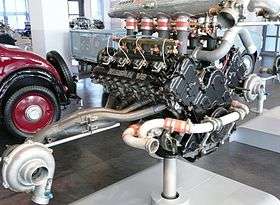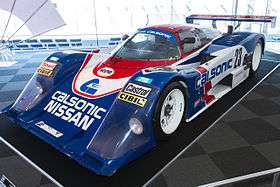Nissan VRH engine
The VRH engine family consists of several racing engines built by Nissan Motor Company beginning in the late 1980s. All VRH engines are in a V8 configuration and can be either naturally aspirated or forced induction in design. Some of the VRH engines are loosely based on Nissan's production V8 blocks including the VH and VK engines, while others were designed from the ground up for racing and share no components with production blocks.
| Nissan VRH engine | |
|---|---|
 | |
| Overview | |
| Manufacturer | Nissan |
| Production | 1988–1998 |
| Layout | |
| Configuration | 90° V8 |
| Displacement | 3.0 L (2,996 cc) 3.4 L (3,396 cc) 3.5 L (3,495 cc) 3.5 L (3,499 cc) 5.0 L (4,997 cc) |
| Cylinder bore | 85 mm (3.35 in) 93 mm (3.66 in) 96 mm (3.8 in) |
| Piston stroke | 62.5 mm (2.46 in) 64.39 mm (2.54 in) 66 mm (2.60 in) 77 mm (3.03 in) 86.3 mm (3.40 in) |
| Block material | Aluminium |
| Head material | Aluminium |
| Valvetrain | DOHC 4 valves x cyl. |
| Compression ratio | 8.5:1, 9.0:1, 13.8:1, 14.0:1 |
| Combustion | |
| Turbocharger | IHI (some versions) |
| Fuel system | Fuel injection |
| Management | ECCS-R-NDIS or Nissan Electronics/Hitachi HN-1 |
| Fuel type | Gasoline |
| Oil system | Multi-stage dry sump |
| Cooling system | Water-cooled |
| Output | |
| Power output | 450 PS (331 kW; 444 bhp) 500 PS (368 kW; 493 bhp) 530 PS (390 kW; 523 bhp) 650 PS (478 kW; 641 bhp) 750 PS (552 kW; 740 bhp) 800 PS (588 kW; 789 bhp) |
| Torque output | 290 lb⋅ft (393 N⋅m) 320 lb⋅ft (434 N⋅m) 325 lb⋅ft (441 N⋅m) 470 lb⋅ft (637 N⋅m) 542 lb⋅ft (735 N⋅m) 520 lb⋅ft (705 N⋅m) 578 lb⋅ft (784 N⋅m) |
| Dimensions | |
| Dry weight | 120 kg (265 lb)? 150 kg (331 lb) 170 kg (375 lb) 185 kg (408 lb) |
V=V engine configuration R=Racing H=The eighth letter of the alphabet = Eight cylinders
History
In 1987 Nissan began work on an engine exclusively for race use and began work on the VEJ30 engine, developed by Yoshikazu Ishikawa. This engine was based on old technology, and was not a success. For 1988 the VEJ30 was improved by Yoshimasa Hayashi and renamed the VRH30. Changes included increasing displacement to 3.4 L (3,396 cc).
This engine was still based on the obsolete VEJ30 and development of the all new VRH35[1] was started in parallel with VRH30. In 1989 the VRH35 appeared as a new development engine and was used in the Nissan R89C. The improved VRH35Z appeared in 1990 in the R90C.
_front-left_2012_Nissan_Global_Headquarters_Gallery.jpg)
In 1997 Nissan, working in partnership with Tom Walkinshaw Racing, fielded an updated version of the engine called the VRH35L in the R390 GT1. This revised engine produces around 650 PS; 641 bhp (478 kW) at 6800 rpm.
The engine was also used in the 1998 Courage Compétition C51[2] Nissan at the 1998 24 Hours of Le Mans. Both cars retired.
The design of the engine was later sold to McLaren Automotive where it formed the basis of their M838T family of engines.[3]
Other VRH Racing Engines
A naturally aspirated 5.0 L (4,997 cc) version, the VRH50A, was used in the Nissan R391. The VRH35ADE, was used by Infiniti in their Indy race car. Other naturally aspirated versions are the VRH34A and VRH34B, used by Nissan in their Nissan GT-R Super GT race car beginning in 2010.
The VRH34A is a 3.4 L (3,396 cc) that produces 450–500 PS (331–368 kW; 444–493 bhp) and over 290 lb⋅ft (393 N⋅m) of torque.
The VRH34B is a 3.4 L (3,396 cc) that produces 500–530 PS (368–390 kW; 493–523 bhp) and over 325 lb⋅ft (441 N⋅m) of torque.
The VRH35ADE is a 3.5 L (3,495 cc) that produces 650 PS (478 kW; 641 bhp) at 10700 rpm and 320 lb⋅ft (434 N⋅m) at 10400 rpm.
The VRH50A is a 5.0 L (4,997 cc) that produces 650 PS (478 kW; 641 bhp) at 7200 rpm and 470 lb⋅ft (637 N⋅m) at 6000 rpm.
The VRH engines also formed the basis for McLaren's M838T engine used in the McLaren MP4-12C supercar.[4]
Specification of VRH30T

- Cylinder Block: Aluminum 90° V8
- Aspiration: Twin-Turbo (IHI)
- Valvetrain: DOHC, 4 Valves per Cylinder
- Displacement: 3.0 L (2,996 cc)
- Bore x Stroke: 85 mm × 66 mm (3.35 in × 2.60 in)
- Power: 750 PS (552 kW; 740 bhp) at 8000 rpm
- Torque: 542 lb⋅ft (735 N⋅m) at 5500 rpm
Specification of VRH35Z
_-_Motor.jpg)
- Cylinder Block: Aluminum
- Aspiration: Twin-Turbo (IHI)
- Valvetrain: DOHC, 4 Valves per Cylinder
Displacement: 3.5 L (3,495 cc)
- Bore x Stroke: 3.35 in × 3.03 in (85 mm × 77 mm)
- Compression Ratio: 8.5:1
- Power: 800 PS (588 kW; 789 bhp) at 7600 rpm
- Torque: 578 lb⋅ft (784 N⋅m) at 5600 rpm
- Engine Management: ECCS-R-NDIS
- Weight: 185 kg (408 lb)
Specification of VRH35L
- Cylinder Block: Aluminum
- Aspiration: Twin-Turbo (IHI)
- Valvetrain: DOHC, 4 Valves per Cylinder
- Displacement: 3.5 L (3,495 cc)
- Bore x Stroke: 85 mm × 77 mm (3.35 in × 3.03 in)
- Compression Ratio: 9.0:1
- Power: 650 PS (478 kW; 641 bhp) at 6800 rpm
- Torque: 520 lb⋅ft (705 N⋅m) at 4400 rpm
- Dry weight: 170 kg (370 lb)
Specification of VRH35ADE
- Cylinder Block: Aluminum-alloy block and heads; molybdenum coated pistons
- Aspiration: Naturally Aspirated
- Valvetrain: DOHC, 4 Valves per Cylinder
- Displacement: 3.5 L (3,499 cc)
- Bore x Stroke: 93 mm × 64.39 mm (3.661 in × 2.535 in)
- Compression Ratio: 13.8:1
- Lubrication System: Multi-stage dry sump
- Oil Capacity: 12 US qt (11 L)
- Power: 650 PS (478 kW; 641 bhp) at 10700 rpm
- Torque: 320 lb⋅ft (434 N⋅m) at 10400 rpm
Specification of VRH34A

- Cylinder Block: Aluminum
- Aspiration: Naturally Aspirated
- Valvetrain: DOHC, 4 Valves per Cylinder
- Displacement: 3.4 L (3,396 cc)
- Bore x Stroke: 93 mm × 62.5 mm (3.66 in × 2.46 in)
- Power: 450–500 PS (331–368 kW; 444–493 bhp)
- Torque: Over 290 lb⋅ft (393 N⋅m)
- Dry weight: 120 kg (260 lb) ?
Specification of VRH50A

- Cylinder Block: Aluminum, Closed Deck
- Aspiration: Naturally Aspirated
- Valvetrain: DOHC, 4 Valves per Cylinder
- Displacement: 5.0 L (4,997 cc)
- Bore x Stroke: 96 mm × 86.3 mm (3.78 in × 3.40 in)
- Compression ratio: 14.0:1 (estimated)
- Redline: 8000 rpm
- Power: 650 PS (478 kW; 641 bhp) at 7200 rpm
- Torque: 470 lb⋅ft (637 N⋅m) at 6000 rpm
- Engine Management: Nissan Electronics/Hitachi HN-1
- Weight: 150 kg (330 lb)
References
- Super Car Chronicle Part 3 レーシングカーのテクノロジー ISBN 4-7796-0785-X
- Courage Nissan C51
- http://www.caranddriver.com/reviews/2012-mclaren-mp4-12c-first-drive-review-tech-trickledown-page-2
- "Car & Driver: 2012 McLaren MP4-12C Tech Trickledown". 2011-02-01. Retrieved 2011-03-27.
- Yoshimasa Hayashi (林義正). (1991). レーシングエンジンの徹底研究 (in Japanese). グランプリ出版. ISBN 4-87687-114-0.
- Naoshi Kuroi (黒井尚志). (1992). ル・マン―偉大なる草レースの挑戦者たち (in Japanese). 集英社. ISBN 4-08-780158-6.